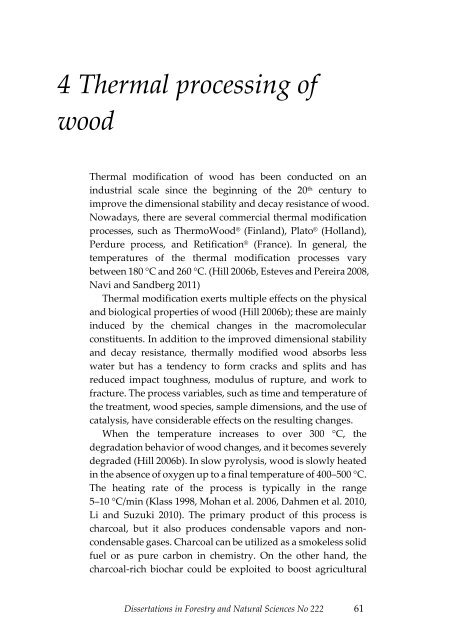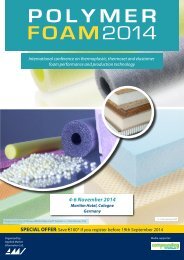Dissertations in Forestry and Natural Sciences
24lYKFN
24lYKFN
Create successful ePaper yourself
Turn your PDF publications into a flip-book with our unique Google optimized e-Paper software.
4 Thermal process<strong>in</strong>g of<br />
wood<br />
Thermal modification of wood has been conducted on an<br />
<strong>in</strong>dustrial scale s<strong>in</strong>ce the beg<strong>in</strong>n<strong>in</strong>g of the 20 th century to<br />
improve the dimensional stability <strong>and</strong> decay resistance of wood.<br />
Nowadays, there are several commercial thermal modification<br />
processes, such as ThermoWood ® (F<strong>in</strong>l<strong>and</strong>), Plato ® (Holl<strong>and</strong>),<br />
Perdure process, <strong>and</strong> Retification ® (France). In general, the<br />
temperatures of the thermal modification processes vary<br />
between 180 °C <strong>and</strong> 260 °C. (Hill 2006b, Esteves <strong>and</strong> Pereira 2008,<br />
Navi <strong>and</strong> S<strong>and</strong>berg 2011)<br />
Thermal modification exerts multiple effects on the physical<br />
<strong>and</strong> biological properties of wood (Hill 2006b); these are ma<strong>in</strong>ly<br />
<strong>in</strong>duced by the chemical changes <strong>in</strong> the macromolecular<br />
constituents. In addition to the improved dimensional stability<br />
<strong>and</strong> decay resistance, thermally modified wood absorbs less<br />
water but has a tendency to form cracks <strong>and</strong> splits <strong>and</strong> has<br />
reduced impact toughness, modulus of rupture, <strong>and</strong> work to<br />
fracture. The process variables, such as time <strong>and</strong> temperature of<br />
the treatment, wood species, sample dimensions, <strong>and</strong> the use of<br />
catalysis, have considerable effects on the result<strong>in</strong>g changes.<br />
When the temperature <strong>in</strong>creases to over 300 °C, the<br />
degradation behavior of wood changes, <strong>and</strong> it becomes severely<br />
degraded (Hill 2006b). In slow pyrolysis, wood is slowly heated<br />
<strong>in</strong> the absence of oxygen up to a f<strong>in</strong>al temperature of 400–500 °C.<br />
The heat<strong>in</strong>g rate of the process is typically <strong>in</strong> the range<br />
5–10 °C/m<strong>in</strong> (Klass 1998, Mohan et al. 2006, Dahmen et al. 2010,<br />
Li <strong>and</strong> Suzuki 2010). The primary product of this process is<br />
charcoal, but it also produces condensable vapors <strong>and</strong> noncondensable<br />
gases. Charcoal can be utilized as a smokeless solid<br />
fuel or as pure carbon <strong>in</strong> chemistry. On the other h<strong>and</strong>, the<br />
charcoal-rich biochar could be exploited to boost agricultural<br />
<strong>Dissertations</strong> <strong>in</strong> <strong>Forestry</strong> <strong>and</strong> <strong>Natural</strong> <strong>Sciences</strong> No 222 61



